► New BMW i5 vs Lucid and Neo
► Establishment vs the newbies
► Which executive EV comes out on top?
Take the best of Tesla and Jaguar, and you get the Lucid Air. So, how does the hot ticket BMW i5 in its hottest M60 guise fare against the upstart start-up, as well as Nio’s super serious, super sophisticated ET7?
Pre-flight briefing: BMW i5 M60
Following the iX1, iX3, i4 and i7, the i5 is another battery-propelled BMW that shares a lot with a combustion car. A rear-wheel-drive eDrive40 model is available, but we’ve gone for the range-topping all-wheel-drive M60 xDrive. Want to know what an all-electric BMW M5 would be like? Well, this is an EV M5 lite, but not light. At 2.4 tonnes, it’s one chunky monkey.
Price £97,745 (£108,195 as tested)
Powertrain 81.2kWh battery, dual electric motors, all-wheel drive
Performance 593bhp, 586lb ft, 3.8sec 0-62mph, 143mph
Weight 2380kg
Efficiency 3.4 miles per kWh (official), 321-mile range (official), 0g/km CO2
Length/width/height 5060/1900/1515mm
Boot capacity 490 litres
Read our BMW i5 review here
Pre-flight briefing: Lucid Air Touring
With multiple award wins and many glowing reviews, the Lucid Air has high expectations to live up to. Although models with four-figure power outputs are available, the second-rung Touring makes do with a mere 612bhp. Clever engineering reduces weight and boosts aerodynamic efficiency, making this the fastest and most efficient car on test.
Price £111,727 (in Germany, £116,491 as tested)
Powertrain 92kWh battery, dual electric motors, all-wheel drive
Performance 612bhp, 885lb ft, 3.2sec 0-62mph, 155mph
Weight 2200kg
Efficiency 4.9 miles per kWh (official), 450-mile range (official), 0g/km CO2
Length/width/height 4975/1936/1409mm
Boot capacity 625 litres + 283-litre frunk
Read our Lucid Air review here
Pre-flight briefing: Nio ET7
What’s the line-up?
Like Lucid, Nio is a relatively new company; both were formed in 2016. However, while Lucid has concentrated on the one car so far, Nio has a whole range of saloons, SUVs and even an estate on offer. This is the flagship ET7 saloon, which comes with a mighty 644bhp and an impressive array of autonomous driving and safety tech.
Price £78,685 (in Germany, £80,848 as tested)
Powertrain 90kWh battery, dual electric motors, all-wheel drive
Performance 644bhp, 627b ft, 3.8sec 0-62mph, 124mph
Weight 2454kg
Efficiency 3.3 miles per kWh (official), 360-mile range (official), 0g/km CO2
Length/width/height 5101/1987/1505mm
Boot capacity 364 litres
BMW i5 vs Lucid Air vs Nio ET7: the test
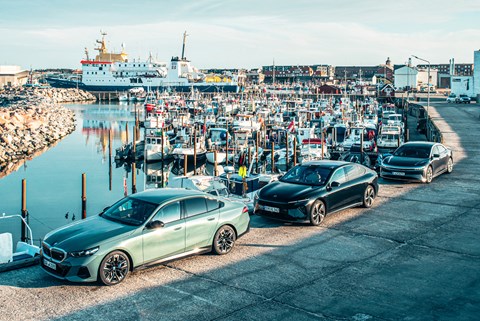
It’s late, and I’m on a deserted stretch of straight road in the Lucid Air Touring. It’d be rude not to try at least one acceleration run, right? With Sprint mode already engaged, I push the brake hard with my left foot while flattening the throttle. After a moment, a small blue bear with a chequered flag unexpectedly appears on screen to announce launch control is active.
Smiling at this whimsical touch, I release the brake pedal and feel my neck muscles tense as we slingshot off the line. At 612bhp, it’s only 19bhp up on the BMW i5 M60 and a whole 32bhp down on the Nio ET7 I’d been driving earlier, but this is acceleration in a different league. I can fully believe the 3.2-second 0-62mph time quoted. Another three runs confirm the acceleration is both brutal and repeatable.
Refreshingly, there’s nothing terribly fancy about the Air’s chassis. Just the front wheels steer via a fixed-ratio rack, it has regular coil springs front and rear paired with adaptive dampers, and there are no trick anti-roll bars. In many ways it’s the most significant new electric executive saloon since Tesla debuted the Model S over a decade ago.
However, we shouldn’t discount the establishment. The launch of any new BMW 5-series is a big deal, let alone the first all-electric version complete with an M-badged range-topper. Our test car has all the available suspension wizardry, combining all-wheel steering, active anti-roll bars, adaptive dampers and an air-sprung rear axle (while the front rides on coils).
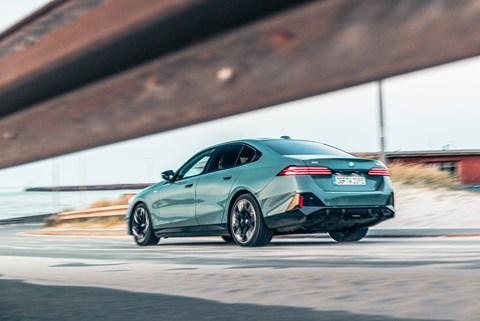
You’d be forgiven for not recognising our final contender, even though it’s been on sale since 2022 (albeit in its native China). Like the Lucid, the Nio ET7 is now available in select European countries with the possibility of it coming to the UK. In a familiar story, it undercuts both rivals here despite having similar performance – like the i5 M60, it can do 0-62mph in 3.8 seconds – while being bigger and crammed full of tech.
This includes air suspension with adaptive dampers on all four corners that’s able to read the road via the ET7’s numerous cameras and sensors, and some very clever autonomous-driving tech. Like the other cars here, it utilises an electric motor for each axle to provide four-wheel drive and has a big battery pack.
Our trio can all charge quickly, although the Air wins with a maximum rate of 250kW on a sufficiently potent rapid charger – that’s enough to get the battery from 10 per cent to 80 per cent full in less than 30 minutes. The i5 isn’t far behind at 205kW and bang on 30 minutes for 10-80 per cent, but the ET7 lags at just 130kW. That said, 40 minutes to 80 per cent isn’t horrific.
With its 90kWh net capacity, the ET7’s battery is ahead of the 81.2kWh i5 but slightly behind the 92kWh Air. Quoted ranges are 360, 321 and a very useful 450 miles respectively, the Lucid’s 200kg-ish weight advantage and slippery aerodynamics contributing to this impressive number.
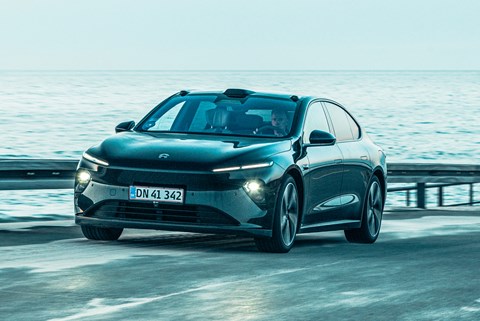
In most driving situations you wouldn’t think the i5 weighed about 2.4 tonnes, at least with the optional suspension. It has a more relaxed gait than the Air, and yet succeeds in avoiding the vague body control that sometimes comes with a comfortable ride. Switching into Sport mode makes it feel more taut but doesn’t turn the ride quality brittle.
The ET7’s comfort is very good, too. It can’t quite isolate the driver from pockmarked roads at urban speeds, but go a little faster and all the occupants are nicely cushioned. The Air is firmer, while still offering a decent level of bump absorption. It’s the damping that really sets it apart, always ensuring that any lump or cavity is dealt with on the first full stroke of the suspension without any crashing or thumping. The Air also has the best body control at speed, tempting you into covering ground at eye-widening pace.
That’s something the i5 is good at, too. You’re perched noticeably higher than in previous generations of the 5-series, and you sit relatively upright. You hold the familiar thick-rimmed M Sport steering wheel, and there’s an ambient lighting bar running across the dash in M colours; it’s far less tacky than it sounds.
You’ll only need to drive a short distance to feel the four-wheel steer at work. It makes squeezing around tight car parks far easier than the i5’s five-metre length would suggest, and it helps turn-in at slower corners as well. It gives a slightly muted sense of connection to the front tyres and can feel a little odd, but it’s not as abrupt in its operation as Mercedes’ similar system can be.
The active anti-roll bars keep the i5 uncannily level in the bends, even when you’re really pushing on. They help mask the hefty weight of the car, and play a part in ensuring good traction off the line or out of bends, with only the odd delay in power when tackling the tightest of radii. You can feel a rear bias to the drivetrain in these situations, although we couldn’t find a way to reduce or switch off the ESC for some livelier cornering.
Maximum power is accessed for 10 seconds at a time via launch control or by flicking a paddle marked Boost. Even without it the i5 is plenty quick.
The Nio is similarly rapid, at least if you’ve put the ET7 in the right mode. If you haven’t, a well driven family hatchback will leave you behind. Select Sport+ and the full 644bhp is available when accelerator meets floor mat. Launch control is easily accessed but, aside from pushing you back in your seat, is as drama-free as the other cars here. Traction is excellent in the dry, and there’s not so much as a chirrup from the tyres as 644bhp hits the ground.
In fact ‘drama-free’ is a good way to describe the overall handling of the ET7. There’s not even a whiff of oversteer, while the electronics subtly nibble the brakes to reduce understeer. The steering is more natural in its responses than the BMW, while giving less feedback to the driver, but there’s more roll and less fun to be had than in today’s rivals. The driving position echoes this, with flat seats that are positioned quite high, like the i5, and a lighter, more lounge-like atmosphere.
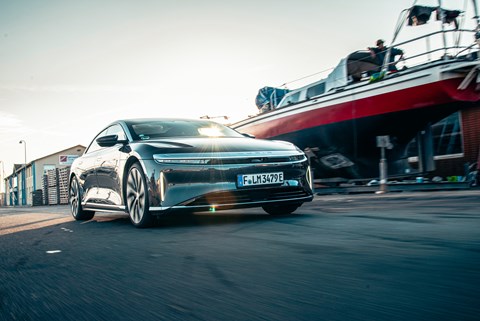
The Lucid Air relishes being driven quickly, unlike the many EVs that feel bulkier and less composed the harder you push them. You sit far closer to the tarmac, with a panoramic view out thanks to the low dash and optional glass roof, making it easy to place the car exactly where you want as you go into a bend. This process is made easier by the most natural-feeling steering in this test, with no ramping up of ratio as you turn the wheel and a good sense of connection to the front tyres. Compared to the techfest BMW, and most other electric performance cars for that matter, the US contender feels surprisingly organic.
Scythe through a tight S-bend at speed and you’re fleetingly aware of the masses involved, but the easily modulated brakes stand up well to a workout and there’s precious little roll despite the comparatively simple suspension system. Even with over 600bhp to channel, traction is exceptionally good, and the Air is happy to tighten its line under power if you slacken the electronic safety net.
You’ll need to prod fairly hard to do this, the Air having an almost Bentley-esque weight to the throttle pedal. It’s totally unnecessary, but somehow adds to the feeling that this is a quality product. Wind and road noise are hushed, yet the motors are perhaps a bit more audible than you’d expect when you accelerate hard. Still, there’s something appealing about the supersized Tamiya noises emanating from between the front and rear wheels.
Arguably it’s more alluring than Hans Zimmer’s sci-fi noises coming from the i5’s Iconic Sounds generator. They’re amusing for a few minutes, but I soon turn them off. There’s no such gimmickry in the Nio, just a focus on hushed progress that’s overall more successful than the i5.

Poking and prodding at the interiors of our trio, it’s the Air that impresses most. The real wood trim, supple leather and impeccable build suggest a proper luxury product that entirely justifies the highest price on test. Most controls are looked after by a trio of touchscreens that are slick in both looks and operation, although the physical buttons for temperature and key stereo controls are welcome.
There’s absolutely nothing wrong with the i5’s interior, assuming you like the current fad for piano-black trim, precious few buttons and a large, curved display. It feels well-made, premium and very much in keeping with BMW tradition; it looks and feels like an expensive version of the 5-series, whereas the Lucid seems to be from a class above, and is priced accordingly.
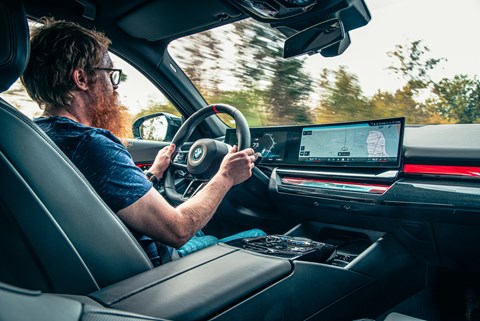
The BMW’s infotainment isn’t quite as easy to navigate as the Lucid’s, but thanks to the familiar iDrive controller, with shortcut icons around it, it’s not too taxing either when stationary or on the move. Graphics and response are good, although the pages of icons are a pain to look through when you’re driving; that can be avoided by personalising your home screen to include the stuff you use the most. The previous generation of iDrive is undoubtedly simpler to navigate.
The i5 is nonetheless easier to operate than the ET7, which has next to no physical controls and non-existent labelling for most of them. You could spend a lot of time figuring out the full list of functions that can be controlled via the steering wheel, and the touchscreen has menus that are full of options that can be hard to work out at a glance.
We’ve no complaints regarding the resolution and snappiness of the system, while Nomi – the voice-activated assistant on top of the dash – is pretty good at interpreting your commands and proves quite endearing. Simple animations are cleverly and classily done, and it rotates to face you when you speak to it, with a whirring noise that might take you by surprise at first, as we’ve become used to electric cars being so hushed.

However, while the light wood-effect trim, soft leather and other appealing materials above the armrests are pleasant, the flimsy lid of the big cubby between the seats is poor in a car this pricey, while plastics lower down feel like they’d be more at home in a mainstream hatchback than a luxury car. Even taking the ET7’s relatively low price into account, it’s disappointing.
Although niceties like soft-close doors, a 1000-watt Dolby Atmos audio system and winged headrests for more comfortable snoozing in the back are nice, we’d rather the money was spent on making it feel properly plush inside.
Its greater size compared to its rivals does make for plentiful legroom in the rear, although it’s headroom that’ll be an issue first for those beyond six feet tall. There’s a conventional three-seat bench, with the outer two seats getting heating, ventilation and even massage like the fronts.
You’d think the low-slung Lucid would be a struggle for lanky adults, but clever packaging means you sit far lower than the other cars here, so headroom is pretty good. Air Pure and Touring models get a smaller battery than pricier variants, boosting rear legroom to generous levels.
Both the Nio and the Lucid give you more space to lounge in than the i5. You’re sat fairly upright, with good headroom and decent space for your knees, but the front seats are noticeably closer than in the other two cars. It’s also the only car here not to have a flat floor, something a centre rear passenger won’t like.
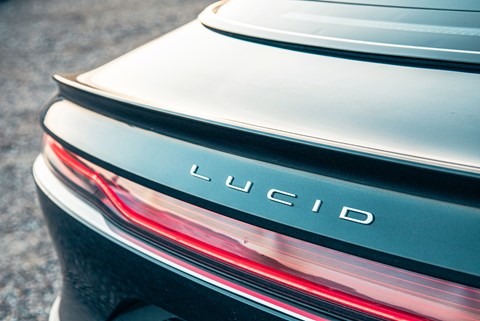
If you value a sizeable boot, the ET7 should be bottom of your list. Despite the car’s size, it’s a mere 364 litres, there’s no frunk, no way of folding the rear bench and not even a glovebox. A car that’s 5.3 metres long surely shouldn’t have a smaller loadbay than a Volkswagen Golf. Even the racier Porsche Taycan beats it by two litres and has an 81-litre cavity under the bonnet.
The i5 is much better here, with 490 litres of capacity and a folding rear bench, albeit no frunk. Surprisingly, though, it’s the sleek Air that’s most practical, at least on paper. It has easily the biggest opening here and – including a large underfloor cubby – has 625 litres of boot space.
If that’s not enough, you can fold the rear bench down for longer items and there’s still space under the bonnet for more luggage. This isn’t just a token slot for your charging cables, either. At 283 litres, this frunk is only nine litres short of a Ford Fiesta’s boot space on its own. Neither load area is particularly tall, so you’re still going to struggle with something like a washing machine. The Tesla Model S and Mercedes EQS score here with their hatch rear openings, although the i5-rivalling EQE has a regular boot. None of these cars bills itself as a load-lugger, but when you’re paying a good sum of money for a big car you want it to be able to do just about everything, regardless of its energy source.
BMW i5 vs Lucid Air vs Nio ET7: the final reckoning
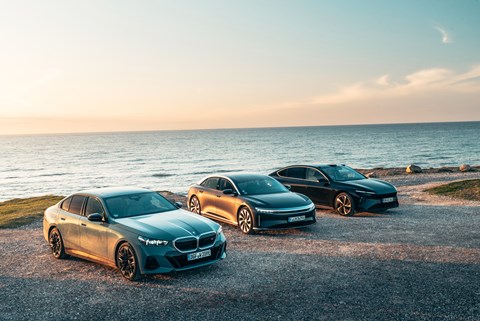
The last decade has been one of unprecedented change within the auto industry, with the rise of the electric car helping to level the playing field somewhat, giving new arrivals a chance to compete with the long-established giants of the business. In the 15 years since the original Roadster’s introduction, Tesla has gone from making a few hundred cars a year to well over a million, and we wouldn’t bet against it happening again with another start-up car company.
Could that manufacturer be Nio? Well, a few shonky interior fittings certainly didn’t get in the way of Tesla’s meteoric rise, and there’s not much wrong with the way the ET7 drives. Some might wish for a bit more involvement to go alongside the lively acceleration, but the Nio is far from alone among high-performance electric cars in being short of personality.
A large executive saloon should be comfortable, and the Nio delivers, while the impressive autonomous functionality adds to the laid-back vibe. There are some EQS-grade luxuries sprinkled in the standard equipment list, yet there are parts of the interior that are more EQA than EQS. With a pokey boot counting against it as well, third place beckons.
Yes, the i5 is quite a bit more expensive than the Chinese car, especially if you raid the options list for the trick suspension, real leather seats and a few other features that you might well expect to be included in a near-£100k car, but it is worth it. It feels more solidly built and easier to fathom inside, with a better balance between rear seats and luggage space. Performance is similar to the ET7, yet the i5 feels far happier to be driven quickly and is certainly more capable.
The way it doggedly resists roll as the four-wheel steer magically seems to shrink the wheelbase of the car is quite something, and it doesn’t come at the expensive of ride comfort. In fact, it’s the comfiest car on test. There are times, though, when it feels slightly unnatural – a criticism that can’t be levelled at the Lucid Air. The US saloon is one of those cars that just feels right within the first few hundred yards, giving you a glimpse of what’s to come. The three-figure weight advantage over the other cars gives the best handling and range, while it involves and entertains more, too.
Then there’s the sensible stuff. It has the longest range, the fastest rapid charging time and is the most efficient. The Air is also spacious inside and has a useful amount of boot space when you take into account under-floor and under-bonnet storage.
And while we’re not claiming a six-figure car is a bargain, it somehow feels like it is, given the time and engineering that’s gone into making such a polished and desirable car. Fingers crossed it makes it to the UK in right-hand drive.
BMW i5 vs Lucid Air vs Nio ET7: the verdict
First place
Lucid Air
Out-Taycans the Taycan, with greater space and luxury too
Second place
BMW i5
A very good car, but not a great one. Try the rear-wheel-drive 40
Third place
Nio ET7
Impressive pace and plenty of toys. Feels a bit Fisher-Price in places